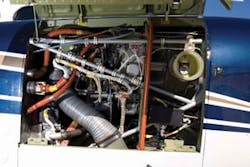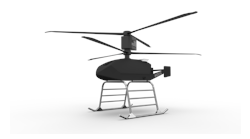From Legacy to Leading Edge:
In aviation maintenance jargon, the term “aircraft quality” usually describes something that works the first time, every time, and lasts a long time.” This definition would certainly apply to the Pratt & Whitney Canada (P&WC) PT-6 turboprop engine. The PT-6 core engine could be the icon for “Aircraft Quality.”
In May 2010, P&WC chose the prestigious setting of the European Business Aviation Convention and Exhibition (EBACE) in Geneva, Switzerland, to celebrate 50 years of service and recognize the contribution the PT-6 engine has made to the company and the aviation industry at large. P&WC began designing and developing the PT-6 in the mid-‘50s. On May 30, 1961, the prototype was mounted on a Beech 18 at de Havilland’s Downsview facility for its test flight. The PT-6 performed as advertised and the first production engine PT-6A S/N 20001 was delivered to Beech on Dec. 22, 1963.
To appreciate the PT-6 story you have to understand the company that builds it. P&WC is a company that is in a continuous state of innovation and transition, focusing on improving core products while pushing research and development. In the 1930s it was servicing the Canadian bush flying business. In the 1940s it was heads down producing and servicing the radial engines used to power the Allied Army and Air Force aircraft. After the war ended it moved into peace-time manufacturing, and in a few short years had made the exponential transition from radial piston to gas turbine engines.
P&WC now has a true global footprint. According to current P&WC president John Saabas, “Somewhere in the world a P&WC-powered aircraft takes off or lands every second. “P&WC engines power the largest fleet of business and regional aircraft and helicopters. They have 10,000 operators and 700+ airlines in more than 198 countries.”
Success of PT-6
On Oct. 20, 2009, P&WC announced that it had delivered its 70,000th engine (a PT-6A-60A turboprop delivered to Hawker Beechcraft Corporation and installed on a King Air 350). Why has P&WC become a global leader when so many other aviation companies have struggled, merged, or failed? In my opinion, it was the beloved PT-6, that backward-mounted turbine engine that is admired by owners, operators, pilots, and maintenance techs alike. According to P&WC, it has delivered more around “46,000 PT-6 and today 26,000 of those engines are still flying.”
What made the PT-6 so successful? Its simple straightforward design. It is reliable, dependable, and easy to manufacture and maintain. It has two independent turbines; one driving a compressor in the gas generator section, the second driving reduction gearing for the propeller.
The core turbine engine consists of two sections that can be easily separated for maintenance. The compressor and power turbines are located in the approximate center of the engine with their shafts extending in opposite directions. This provides for simplified installation and inspection procedures. A two-stage planetary gearbox is located in the front of the engine and provides the speed reduction between the power turbine and the propeller shaft. An accessory gear case is located at the rear of the engine with the relevant accessory drives and mounting pads. The larger PT-6A models get their increase in horsepower from an additional four-stage axial configuration.
PT-6A engines are available in more than 65 models ranging in power from 500 to over 2,000 shaft horsepower. They come in three basic sizes — small, medium, and large. The small (PT-6A-11 to A-36) delivers 500 to 750 shaft horsepower and measures 25” H x 21.5” W x 62” L. The medium (PT-6A-38 to A-45R) delivers 700 to 1,200 shaft horsepower and measures 22” H x 19.5” W x 67 to 72” L. The large (PT-6A-52 to A-68) delivers 1,050 to 1,700 shaft horsepower and measures 22” H x 19.55” W x 67 to 76” L. The ubiquitous PT-6s are currently powering about 100 diverse aircraft types. Some example are: the Beechcraft King Air, Cessna 208 Caravan, de Havilland Canada Dash 7, Piaggio P180 Avanti, Bell/Agusta BA609, and the Sikorsky S-76B.
Still redefining technology
It is remarkable that after 50 years, the PT-6 is still redefining the possibilities of turbine engine technology. Former P&WC president and CEO Gilles Quimet said, “The PT-6 turboprop family is one of our great success stories. Over the past five decades, it has established an enviable record for reliability and durability and proven to be a workhorse for thousands of aircraft around the world.”
Through the years, P&WC design engineers have been busy modifying and improving the core PT-6 engine. Pilots now have digital electronic controls. Other modifications have reduced exhaust emissions, and increased maintenance intervals. New aerodynamic and material technologies have enabled the PT-6 engine to gain more power without significantly increasing in size.
It now appears that DNA from that prototype PT-6 developed 50 years ago will live on in new P&WC turbine engines. During EBACE 2010, P&WC announced the creation of a new multidisciplinary team with a mandate to create an even more impressive PT-6 engine. “The technology that will come from this development initiative may also be applied to existing PT-6 engine models.”
Durability and maintainability
I wanted to corroborate the PT-6’s reputation for durability and maintainability. I called Chris Pratt, director of marketing and strategic planning, engine repair and overhaul for Dallas Airmotive. I asked Chris if he could put me in touch with some maintenance folks that had extensive PT-6 experience. I received a call from Joe Capra, program manager; Ryan Saxer, senior customer service representative; and Olof Beyer, chief engineer/customer service engineer. I asked them what makes the PT-6 so reliable. These experts said that for what it is designed to do, the PT-6 is a rugged, perfectly designed turbine engine. It is the “John Deere Tractor” of turboprops.
“It is very forgiving and hard to over temp and over torque. There are limited AD notes and the main bearings are not a life-limited item when operated under basic times between overhaul (TBO). You can separate the engine at the C flange and inspect the hot section on the wing and the TBO is about 3,600 hours. If you do need service in the field, the free turbine design makes this engine easy to maintain. The PT-6 is so widely used that if it does require maintenance, regardless of where you are, you can get parts within a couple of days.”
I asked Joe Capra for some customer feedback. Some customers commented that “Engine dependability is not something that concerns us.” “Reliability is not an issue, they just don’t break.”
In April of 1991, the dependability of the PT-6 engine was demonstrated during a high-profile emergency medical rescue mission to extract an ailing Dr. Ronald Shemenski from the Amundsen-Scott South Pole research center. The mission was made during the brutal, totally dark, -60 F Antarctic winter. The plane used for the mission was a Twin Otter turboprop powered by two aircraft quality PT-6 engines. The Twin Otter was piloted by Captain Mark Cary who flew from Canada to the South Pole and back without a hitch.
Happy 50th birthday to the PT-6. You remind me of one of my favorite children’s story about another little engine that could. AMT
Charles Chandler is AMT’s Field Editor. He received his A&P from Spartan College of Aeronautics.


